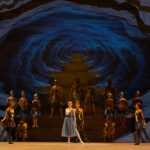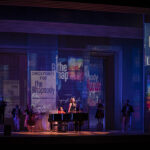Upper Manhattan is Reborn Upstate
Take a Tony Award-winning musical featuring a large cast of dancers and flamboyant choreography infused with salsa, merengue and hip-hop. Surround this cast with scenery that depicts the working storefronts of a bodega, a hair salon and a car service. Light it up with dozens of colors, patterns in motion and — in a purely 21st-century moment — the glow of smartphone screens.
Now, put the whole thing on a stage described as a “prothrustium,” a well-equipped but compact stage with a pronounced thrust, placing the audience on three sides of much of the action.
This is what happens when In the Heights, the first musical written by Lin-Manuel Miranda (who went on to write the award-winning Hamilton), opened the 45th season at Geva Theatre Center in Rochester, NY.
This LORT resident professional theatre has taken on some daring and complex productions in recent years, including last season’s stunning world premiere of the drama Other Than Honorable. In the Heights serves as an exciting example of the theatre’s current direction, led by twenty-three-year artistic director Mark Cuddy.

Music and Movement
In the Heights tells the stories of several families in Washington Heights, the northern Manhattan neighborhood in which Miranda grew up. Usnavi De La Vega owns the bodega his parents left in his care when they died; Nina Rosario is the daughter of the car service owners and the first in her family to go to college; Vanessa is an employee of the hair salon and is desperate to find a decent apartment that she can afford. In between, the interwoven dramas are songs that readily break out into vibrant dance sequences, representing the diverse and colorful backgrounds of the people who live and work here.
Dominated by music and movement, the show’s energy would fill any full proscenium, but at Geva, it has the potential to become a very tight fit. It’s a credit to the direction and the designers that it feels just right in this fairly close space, losing none of its vitality or excitement.
“It’s a neighborhood that eats, sleeps and lives with each other,” said Melissa Rain Anderson, who directed the show for Geva. “It’s important to see the tight bond of the community, and it’s also about how tightly they live with each other. They rely on each other for service.”
To accomplish this, the scenic design by necessity borrows from the Broadway production — the high-rise apartment buildings and the three storefronts — while taking advantage of the Geva stage’s open architecture. Anderson worked with scenic designer Adam Koch to conceive a set with a practical second level, taking the dancers up above the storefronts to roofs and balconies.
“The story does take place on the street, so going up into the space above the shops gives it a vaster expanse, a broader feeling, while also helping to keep it jam-packed,” said Anderson. “Adam’s done an amazing job giving us levels to play with. Fire escapes, ladder, stair units, we can play on the rooftops. We get the feeling of going up into the space, which works so well on the Geva stage.”

Home Stage Advantage
Anderson knows the space so well because she serves as an artistic affiliate at Geva, taking on large, complex productions like Monty Python’s Spamalot! and A Funny Thing Happened On the Way to the Forum. “We’re not portaling in the set,” she said, referring to a common practice of building a false proscenium to create a traditional portal, with the action taking place inside its frame. “This set literally goes until it’s offstage.”
Anderson strove to create a contemporary feel for the show without grounding it in its 2005-2008 origins. “I thought what was important was telling the visual, emotional journey Lin was talking about at the time,” she said. “So we’ve preserved the feeling without saying the date. The way to feel about this show now is more emotional, kinesthetic. The idea of saturation, of a fairy-tale feel, goes into all parts of the show.”
To this end, Anderson and Koch selected a multicolor palette that helps extend the show’s impact beyond the realities of this century’s first decade. “That’s my favorite part of what we’re doing,” said Koch. “There’s a legend that says that Lin-Manuel got the inspiration for this show from walking through his neighborhood and hearing all the different music, from different buildings, different blocks. I wanted to reflect that with an eclectic palette. There’s a colorful, more expressive way to represent New York than with realism.”
Koch’s scenic design turns the George Washington Bridge an electric purple, washes the buildings with sunset shades of gold and orange and brightens the stage floor with crisscrossing bands of bright and dark blue. Fire escapes glow in red slashes against shades drawn over windows, and even the rolling doors over the storefronts pulse with raspberry, burnt umber and turquoise hues.
“Like a lot of good stories, there’s a magic in this show,” said Koch. “This is a classic Greek comedy: the overall set is one location where everyone comes and goes. It’s a stationary shot of the street, a permanent setting. If anything the show is about the importance of home and family. A show that’s all about returning to your roots, finding acceptance of where you came from — it’s the bedrock of the whole story, the corner they all grow up on.”
That being said, conforming the musical to the Geva stage presented some issues. “There were some practical challenges to see into all the shops, making them visible to everyone in the house,” he said. “But the artistic challenges were harder. Trying to deliver everything this show needs practically, and still design it through my own prism. For better or worse, there’s always a lot of precedent to be like the Broadway show. There’s nothing to say what they did originally was sacred, so we look at what is already there and what we can bring there as well. When good artists attack the same script, they often come up with the same answers.”
1000 Cues, and Counting
Lighting designer Brian Lilienthal was grateful for Geva’s robust electrical inventory as he watched a run-through rehearsal a few days before tech rehearsals began. “I’m going through my script, and I’m on page 56 right now and I’m up to cue 435. There are about 120 pages. It’s a pretty large lighting show, just because of the style of the music.”
Lilienthal has an unusual advantage, however. “I grew up as a drummer, so music and I are pretty tight,” he said. “The cues come from the staccato nature of the music and all the stops and breaks.”
Making the most of Julio Agustin’s effervescent choreography becomes the lighting designer’s job, especially in a show that unites a range of musical styles with rap exposition and action.
“When talking about the show with Derek [Madonia, Geva master electrician], I said there’s so many quick changes, we need a bunch of LED fixtures to change the color on those counts,” Lilienthal said. “Luckily, they had a little money and could buy sixteen ETC ColorSource PARs. Coupled with the theatre’s moving light package and scrollers, we’ve gotten the most we can with the money available. Getting over to the LED side of the world, it’s really fantastic.”
The LEDs allowed Lilienthal the flexibility to change colors on the beats of the music, creating a light show that matches the energy and vitality of the dancing. Patterns emerge and vanish, thanks to moving effects using Varilite VL 3000s and VL 1000s. Two Roscoe I-Cue Intelligent Mirrors give the designer the flexibility to reposition beams of light from specific specials.
“We’re not trying to hide anything,” said Lilienthal. “I’m bringing the theatrical-ness of it. We have pretty tall booms right on the proscenium. We’re not trying to fool anyone into thinking this is an actual street. It’s not a naturalistic musical, so we’re pushing the edge of the envelope and really bringing the joy out of the story. My approach is to try to elevate that as much as I can.”
At the same time, Lilienthal uses Koch’s brightly colored set to create a sense of dimension. “There’s a lot of sculpting on the set, making it as sharp and angular as we can,” he said. “It can feel pretty flat pretty quickly, so I’m trying to really light it the way I’m lighting a dancer. Push the angles, bring the architecture into full relief.”
Hot Setting, Hot Colors
Color plays a major role in Lilienthal’s thinking as well. “It’s in the middle of the summer, so there’s a lot of hot colors,” he said. ““It’s hot and stagnant air and hot concrete and pavement. But that’s not to say that there aren’t some quieter numbers that need something a little more romantic, in purples and blues. I’m basing my light on a pale lavender in the conventional fixtures and going from there.”
As I caught up with Lilienthal before the first tech, he still felt that all of these plans might be speculative. “All of that could change once we get into the theatre,” he said. “That’s one thing that I firmly believe in — when you get in the room, you just light the show, and your instincts become informed because of all the research and work you’ve done. Saying a song has to be yellow — that’s not how I work. I’m totally fine with switching gears.”
Geva’s ETC Eos lighting control desk makes cue writing and tech rehearsals move smoothly.
“Tech will be fast and furious and long,” said Lilienthal. “We tech for four days before previews: we have three ten-out-of-twelves,” during which the actors work for ten hours with a two-hour break, according to Actors’ Equity union rules, “and one eight-out-of-ten. Katie Everdyke, the programmer at Geva, is one of the best programmers I’ve ever worked with. I can talk as fast as I can and she never misses a keystroke.”
With so many elements in play, a show like In the Heights has plenty of potential for first-night errors in previews, but the first performance on September 5 moved nearly flawlessly through its frenetic paces. The packed house rose to its feet with one motion to cheer the cast as they took their bows.
“I think one of the things that is probably really great for the Geva audience is seeing this kind of play with this kind of cast,” said Lilienthal. “There’s a lot of Spanish being spoken. It’s not your standard musical theatre fare. It can bring a completely different style to an audience that might not have been exposed to it before. And with this hot of a production — it’s going to ask people to think about where they come from and what they think of the world. For me, just listening to this music has opened me up to some of the styles as well.”


